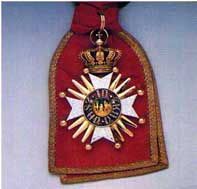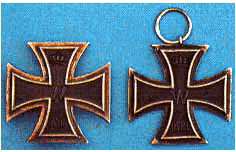Decorations have a long history. It
is proven that awards in ancient times were given solely for military achievements. The Greeks called
them “tafalara;” the Roman word was “phalera.’
Both words had the same meaning: Award. This word, “phalerae,”
was used to classify the science that studies orders,
decorations and their history – “phaleristic.”
Some years ago, phaleristic was just an interesting
field among numismatic. A Phalere was a circle or
crescent-shaped plaque approximately 4 inches in
diameter that was worn by war horses. Later, those
plaques were mounted to the soldiers’ armor. Those
phaleren are still visible on Roman tombstones. Besides
the phalere, several other decorations existed. Those
are the wreaths (“corona”) worn on the head, rings
(“torques”) or batons (“vitis”).
During the Crusades in the 11th
century, knights formed into orders in a sense of a
society devoted to humanity and beneficence. Their ideas
came to form four knight orders. The Order of the Holy
Sepulcher was founded after storming Jerusalem in 1099
and united with the Order of St. John in 1291; the Order
of St. John in 1118 was formed out of the monks’ Order
of the Holy John of Jerusalem; the Order of the Templar
was also founded in 1118, and merged in 1312 in the
Order of St. John. And lastly, in 1170, the Marianer
knights Order, which later became the German Order, was
formed.
The cohesion among the orders’
members was determined by their rules, their
congregation, the community and the orderliness (lat. ordo).
The affiliation to an order was shown by their uniforms
and insignia. In this regards, it should be said, all
design of those insignias root in the pattern of the
holy cross. Being a member of such a society had nothing
to do with being awarded honors during those early days.
Among the orders’ members, a ranking system was
established and documented by different insignias.
The grand master of these orders
founded multiple branches of their order societies
before the downfall of
Jerusalem
and enhanced their political powers in all parts of
Europe
. Being reinforced through all their gains during the
Crusades and their fast growth, the orders’ masters
were coveted by almost all of the royals. This triggered
the development of awarding memberships in orders.
Envious of this development, the
secular sovereigns started their own societies to
counter the growth of clerical power. The very first
secular knights’ orders functioned as competing societies to bond the knights and royals to
their sovereigns. Besides the political usage of those
orders, an advantage to highlight merits in military and
civil service was seen. Not to be mistaken with the
clerical orders, the secular orders adapted the insignia
of the founders and wore those in quite different ways,
such as on fancy collar chains. Those orders still
weren’t orders/awards in today’s sense. The award
was an underlining of merit to become a member of the
order. The most known order those days was the British
Order of the Garter, founded in 1348 and leading in
style, rank and acceptance up to the present time in
Europe
. Even though the order held tightly to its ancient
rules, it still was forced by society to adapt to
becoming a pure merit order. With the power play between
countries and its constant changing, the function of
those orders was also changed. Even the traditional and
great orders which were founded in the 18th
and 19th century
|
Baden - House Order
of the Trust (Hausorden der Treue)
Bavaria - Order of
St. Hubert (Orden des hl. Hubertus)
Hanover - Order of St.
George (St.-Georgs-Orden)
Hessian - Order of the
golden Lion (Orden vom goldenen
Löwen)
Prussia - Order of
the Black Eagle (Hoher Orden vom
schwarzen Adler) |

Bavaria - Order of St. Hubert
|
were more merit orders than knights’ societies.
This change was definitely sped up
by awarding the insignia of the order
rather than awarding the membership to the order. The special
mark of the community was awarded to an outsider for
merit of all different kinds. This procedure was a step
towards the modern order. During the era of absolute
power, a classic knights’ order with all its rules,
limited membership numbers, religious goals and so forth
could not accomplish the needs during those modern
times.
Nowadays, knights’ societies
don’t exist any more, but anonymous decorations are
worn as symbols for merit. The time around the 18th
and 19th century tinted
by wars easily illustrates why the first founded orders
were solely military orders, and the Military Order of
St. Henry founded in the kingdom of Saxony in 1736 or
the Prussian Pour le Mérite founded by Friedrich II in
1740.
These new orders were mostly
founded with three grades: Grand Crosses, Commanders and
Knights, which were equal to the hierarchy of generals,
staff officers and officers. This base model already had
been introduced for the French order of
St. Louis
, issued in 1693 by Louis XIV for military merit. All
famous German military orders followed the three class
rule, among them the Bavarian Military-Max-Joseph Order
(Form of 1806), the Baden Military
Carl-Friedrich-Merit-Order (1807) or the Wurttemberg
Military-Merit-Order (Form of 1818).
The consolidated states were now
fighting about enhancing their territories in regards to
power, geographic or economic. The founded orders
reflected this situation very well. Orders were mostly
founded for historic wars or single battles. The
Austrian Military-Maria-Therese-Order was founded in
1757 after the battle at Kolin; the Austrian Military
Honor Medal was founded by Joseph II in 1789 after the
Turkish war. Another step in the development of our order system was of course the French Revolution. Trying
to get rid of titles and privileges during that time to
make all men equal went in the opposite direction in
regards to orders. In 1802 the 1st
Consul Napoleon Bonaparte founded the order most known
today, the Order of the Legion of Honor. This triggered
a variety of order foundations. It indirectly inspired
the most popular and known German medal, founded by
Friedrich Wilhelm III in 1813: the Iron Cross.

The Iron Crosses for 1870/71
In over 130 years and four wars, the IC had central
character in regards to medals and in 1939 as an order.
In the beginnings, military orders only honored the
merit of officers. This was changed certainly during the
19th century. NCOs and
enlisted men were awarded military and bravery medals.
Some were actually combined with monetary awards or
installments. Those medals were as well known as
comparable orders. Some even were given names of their
order relatives as, for example, the Pour le M rite for
NCOs, the Prussian Military Merit Cross. The variety of
stars, crosses and medals comes up after the downfall of
Napoleon. Commemorative medals were born in 1813.
Numerous commemorative medals for this war were issued
and mostly cast of metal from the conquered cannons.
Medals for combatants and non-combatants were among
those new creations. War medals were sorted after merit
at the frontline or merit earned at the home front.
During peaceful times, there are medals and orders for
police, firefighters, customs agents, sports players,
scientists, rescue workers …[1]
[1] Nimmergut, Jörg; "Deutsche
Orden";Heyne-Verlag 1979





